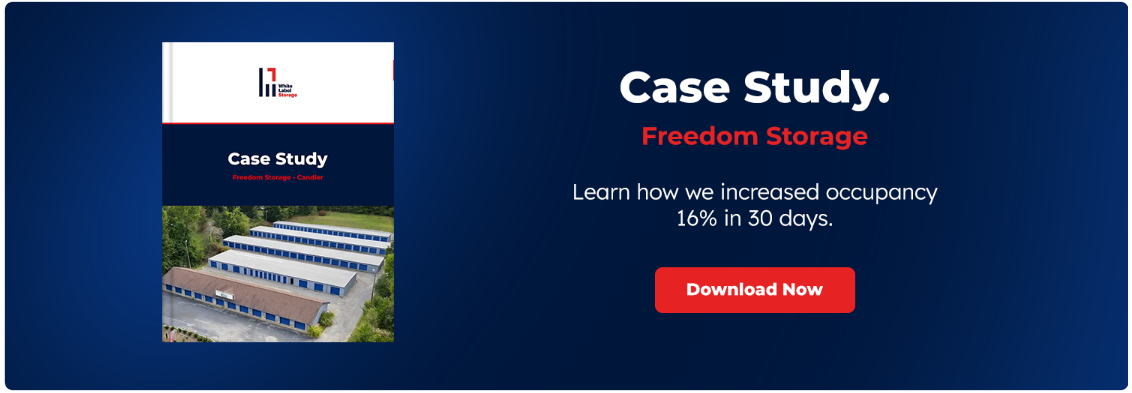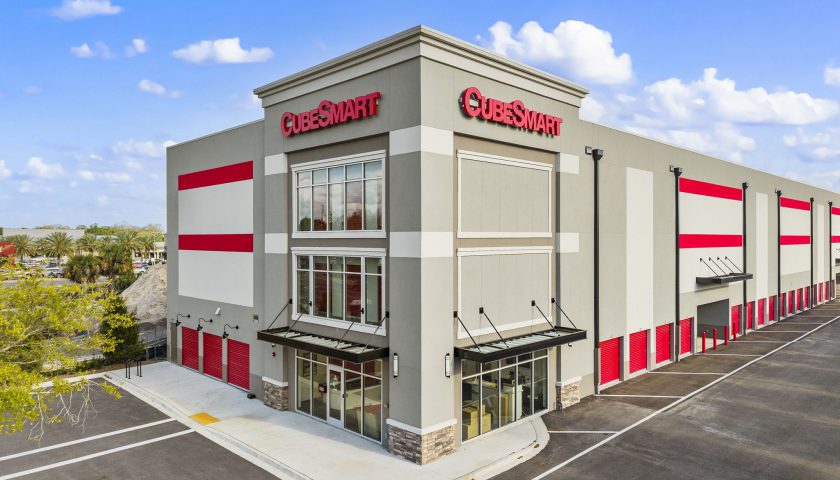58% of people will rent from the first self-storage facility that they call, according to SSA’s 2023 Self Storage Demand Study.
Even in a digital-first world, there will always be a segment of tenants who want to speak to a real person on the phone. Consequently, operators who consistently pick up the phone have a better chance of closing more leads and raking in more revenue.
But it’s almost impossible to maintain a high pick-up rate if you’re relying on a single site manager. One person simply can’t respond to every incoming call throughout the day (and after-hours).
Yet too many properties still rely on this outdated, single-point-of-failure system. And it’s costing them revenue.
In this article, we’ll calculate how missing calls can drain revenue and even lead to negative reviews.
We’ll also dive into why self-storage call centers are a popular solution and how to choose the right solution for your facility.
Calculating Revenue Loss from Missed Calls
Missing a call may seem innocuous at first glance. Is it really a huge deal if you don’t catch every single one?
Let’s run the numbers.
Assume a typical 50,000 sq ft facility receives about 40 inbound inquiry calls per week. The industry rule of thumb is to expect a 35 % phone‑to‑lease conversion rate when those calls are answered in real time.
Missing out on a single new lease may not be the end of the world for your facility, but losses quickly compound over a week or a month.
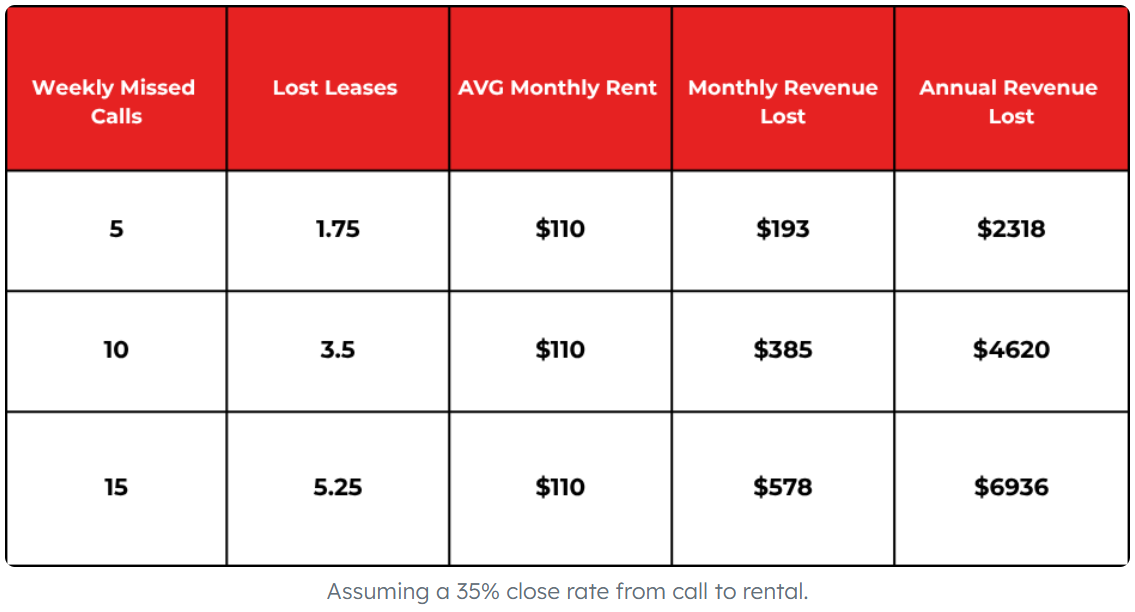
Even 10 missed calls per week bleeds nearly $5,000 in annual rent— and that’s without factoring in ancillary revenue from tenant protection, boxes, or admin fees.
Move that lost revenue line farther down your P&L, and you’ll see NOI erode, debt‑service coverage tighten, and refinancing options shrink.
So yes, missing incoming calls — even if it’s only a few per day — can snowball into a significant drain on facility revenue.
Consider After-hours Call Support
Missed calls don’t just happen during business hours. Numbers vary, but as much as 15-20% of total call volume can happen outside of business hours or on the weekends.
Even if potential tenants leave a voicemail, they won’t wait around for your facility to call them back. Self-storage is often an acute need, meaning people need a solution quickly.
Some experts estimate that missing a call decreases your chance to convert a lead by 52%. That percentage is likely even lower for after-hours calls because the facility won’t respond until the next day.
Unless you’re staffing a night shift, which many smaller facilities can’t afford, utilizing an after-hours call center is the best way to capture these customers.
If you’re not ready to implement that kind of solution, make sure your website supports online booking. That gives customers a resource for viewing your unit inventory and booking right then and there.
Avoid Negative Reviews with Better Customer Service
While it’s critical to answer incoming calls from prospective tenants, it’s also important to consistently answer the phone for your current customers.
In fact, up to 80% of incoming calls are made by existing tenants. Missing their calls can also hurt your revenue, but not in the way you might think.
Many negative reviews for self-storage facilities include anecdotes about poor customer service.
“No one answers the phone” is an all too common phrase.
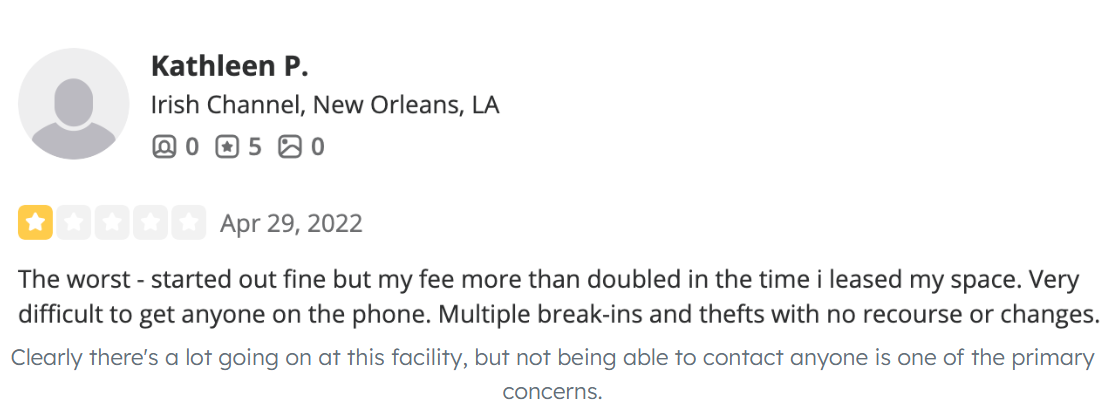
Negative reviews hurt your self-storage SEO, which reduces your rankings in Google and degrades your ability to generate new leads from that channel. Prospective tenants might also think twice about renting at your facility if you have a slew of negative reviews.
Should You Hire a Self Storage Call Center? Here’s the ROI.
If you want to answer more calls and improve the quality of your customer service, you essentially have two options:
1. Hire more staff internally (that includes after-hours)
2. Partner with a self-storage call center service
The economics of hiring a call center make it a more attractive option for most owners and operators. Here are the major benefits:
Convert More Calls Into Tenants
Take our earlier 15‑call scenario. Assume a call center captures those inquiries and converts at 35 %. That’s 5 new leases/month, or 60/year.
At $110 rent and modest tenant churn, you bank roughly $6,600 net new revenue per year.
And it could be much higher if you get more calls or convert at a higher rate. 35% is an industry benchmark, but the right call center provider can close at an even higher percentage.
Keep Customers Happy and Prevent Churn
It’s easier to keep a current customer than it is to bring on a new one. It’s also more affordable.
Customer service is a critical part of self-storage management because it helps your current tenants resolve problems and keeps them satisfied with your facility. As a result, they’re less likely to churn, ensuring you can count on the recurring revenue from their rentals.
Utilizing a call center to answer incoming calls promptly and expedite customer support can have a major impact on tenant retention.
Get More From Your Site Managers
When the phone stops ringing off the hook, on‑site staff can:
- Chase delinquent accounts (lowering auction volume and recovering lost revenue)
- Conduct facility audits (reducing break‑ins)
- Offer in-person assistance to existing tenants (raising review scores)
The operational mindset shifts from reactive to proactive, boosting both income and customer satisfaction.
How to Choose the Right Call Center Provider
There’s a wide array of call center providers, so finding the perfect partner can be overwhelming.
Here’s how to decide:
1. Measurable Performance Metrics
There’s an old business saying, “If you can’t measure it, you can’t manage it.” While that’s not always the case, it definitely applies to call center providers. Here are a few key performance indicators to look for:
Pick Up Rate
The most important stat: How often do incoming calls actually get answered?
Time to Answer
How quickly agents answer the phone matters. The longer the phone rings, the more likely the caller is to hang up.
Customer Satisfaction
A measure of how well agents helped callers resolve their problems. At the end of the day, the customer needs to feel like they got value from the interaction.
Quality Assurance
Call center providers often have internal rubrics they use to measure the performance of agents, like conversion rate, call length, voice tone, etc.
Here’s a snapshot of our call center performance at White Label Storage:
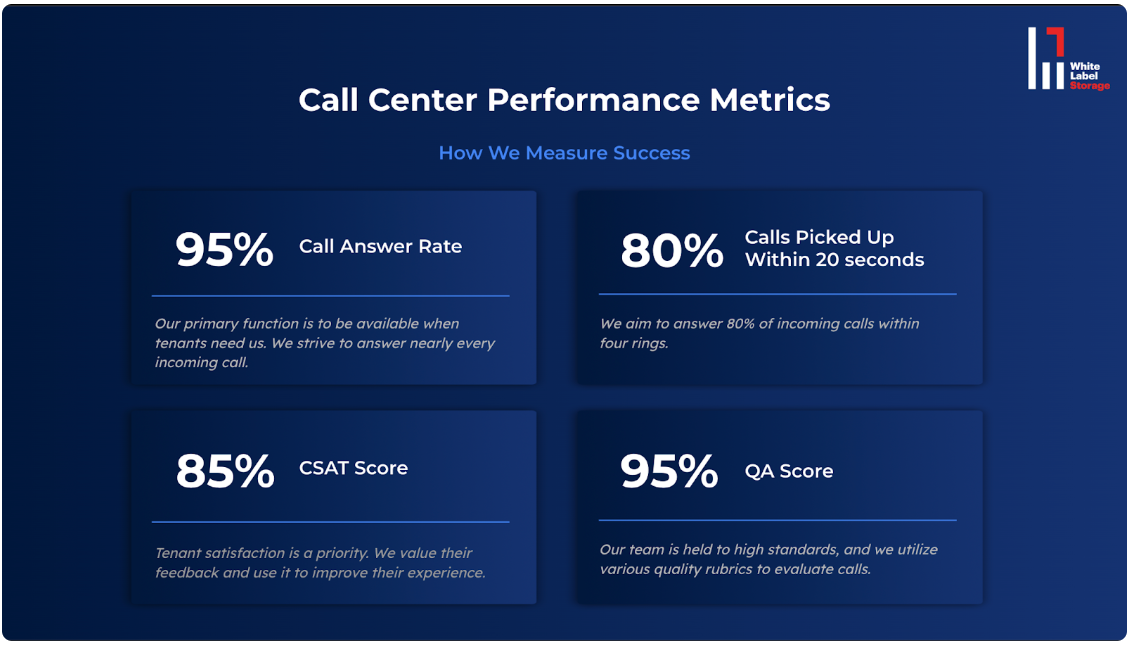
2. Continuous Improvement
Any quality call center should have a program for continuously improving its performance. Ask any potential partner how they approach coaching and performance improvement. Their answer will reveal what you can expect from them throughout the lifetime of your engagement.
3. FMS Integration & Facility-Specific Training
The best call centers deliver personalized service built around the specifics of your facility. When agents engage with a prospect, they should be able to walk them through available units, discuss pricing, and guide the tenant to a rental.
Part of this requires integration with your facility management software (FMS) to view the necessary data. The other part requires a quality training program to rapidly onboard agents and get them acclimated with your facility.
Stop Missing Out on Easy Revenue. Close More Customers From Inbound Calls.
Implementing a call‑center service is a simple, high-return investment that can benefit your facility in numerous ways. First and foremost, it ensures you capitalize on opportunities that are already coming your way. It also helps you reduce costs, improve efficiency, and keep your current tenants happy.
Ready to earn more revenue? Schedule a demo with our team and learn how our call center services can work for your facility.
Author: Zach Watson, White Label Storage Management


